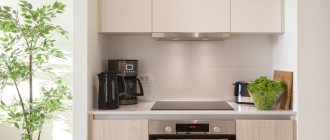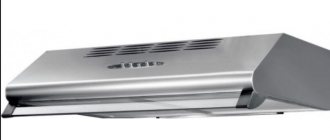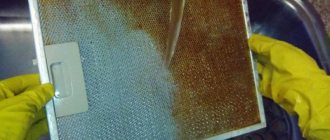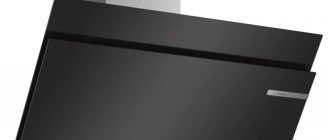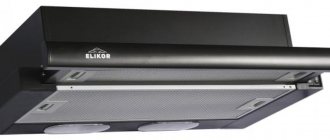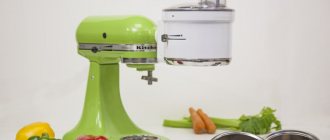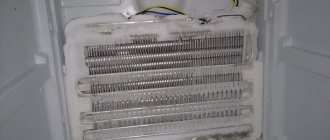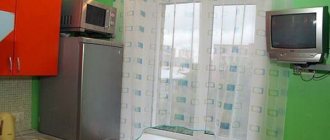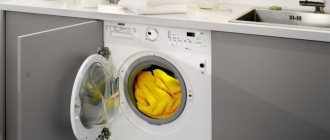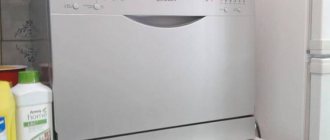All problems with air purification in the kitchen today are solved with the help of specialized household appliances - different types of hoods. They have significant differences in design and basic technical characteristics, but one of the selection criteria is a low level of sound impact. Can the device operate silently? Let's look at what quiet kitchen hoods the market offers and what their operating principle is.
Why are hoods noisy?
The structural components of the air purifying device are an electric motor and a fan. When the hood operates, noise is produced, and how noticeable its level is depends on several factors.
- The power of the motor affects the performance of the fan and the speed of movement of air masses in the air ducts, which affects the higher noise effect. Productive hoods are suitable for spacious rooms.
- The cross-section and length of the air ducts affects the level of noise emitted. The relationship here is the opposite: the small diameter of the channels contributes to high air speed and high noise levels.
- Bends of air ducts and transitions from one section to another cause the formation of air turbulence, which results in noise.
- The form factor of the air ducts affects the operation of the hood in terms of noise effect. A corrugated duct creates more noise than a plastic pipe with smooth walls.
- The installation location of the hood also affects the noise level during its operation. To determine the distance for placing the device, you should adhere to standard calculations: the distance from the working panel of the hood to the electric one is 0.6 m, and to the gas stove – 0.75-0.8 m.
- Poor installation results in vibrations during operation of the device.
- Loud noises from the exhaust hood are caused by faulty operation or contamination. The exhaust system - the work surface, fan blades and air ducts - must be cleaned periodically. To prevent and diagnose malfunctioning exhaust system, it is recommended to contact a specialist.
The hood needs to be cleaned not only outside, but also inside.
Are there silent hoods?
There are no electrical appliances that make no sound at all. Manufacturers strive to produce devices with the lowest possible noise level corresponding to its power . A high-performance device will always have a higher noise level than a quiet, low-power hood.
The following models have a relatively low noise level:
- complete with one exhaust fan;
- devices with thick-walled housings;
- designs that provide high-quality connections that help reduce noise levels;
- devices equipped with acoustic traps to minimize noise effects.
Types of hoods
Manufacturers producing the quietest hoods
Silent models (whose “sound” is less than average) are in the line of each manufacturer. However, some companies stand out in this regard because they have more “quiet” models than others.
List of manufacturers with the quietest hoods:
- Falmec.
- Hansa.
- Cata.
- Krona.
- Teka.
- Elica.
- Maunfeld.
Technologies aimed at reducing noise
To ensure low noise levels during operation, manufacturers use the following methods and technologies:
- Installing two fans instead of one. As a result, the engine speed decreases and it sounds quieter. In addition, dual-fan hoods have more power reserves.
- Increasing the thickness of the body walls. If the housing wall is too thin, the sound will be strong. In addition to the fact that it will not “hold back”, the wall will also resonate. And vice versa: a thick wall “damps” the sound and does not resonate. The disadvantage is that the weight of the product increases, so the thickness can be increased to a certain point.
- The location of the fan is away from the air intake.
- Installation of acoustic “traps” (sound absorbers) inside the housing.
Performance calculation
There are several main parameters of the exhaust system.
- Performance shows how many cubic meters of air the hood passes through the entire structure during an hour of operation.
- The volume of the room where the kitchen is located - the larger it is, the higher the productivity should be.
- The power of the hood depends on the size of the room.
As we see, all these parameters are related to each other, they can be calculated using a simple formula - we multiply the height and area of the room by 12. This is how many times per hour, according to all Russian standards, the air must be completely renewed during cooking.
If you plan to remove polluted air from the room, then the result must be multiplied by a factor of 1.3 - it takes into account the length of the standard air duct, the depth of the shaft, and the number of floors of the building.
For example, you live in a standard five-story house: the kitchen area is only 6 square meters. m., ceiling height is 2.25 m and you choose the outlet option. Then we get 6 x 2.25 x 12 x 1.3 = 210.6 m3/h - you need a hood with a capacity of at least 250 cubic meters. m in. If you install a recirculation system, the result will be 162 m3/h.
Many users will ask - why are these calculations needed? They are made in order to select an acceptable exhaust system specifically for your kitchen. When purchasing a hood, focus on the required performance and the noise level produced.
You need to know that when choosing a new exhaust system, its performance is taken with some margin in order to ensure normal circulation.
Silent hoods: rating of the quietest models
Let’s make a short rating of models that operate without noise (with a minimum level) - this will help the user choose the “quiest” hood. Data is current as of the end of 2021.
Please note: all characteristics (including noise level) were taken from store descriptions, so they may contain errors.
For convenience, we will distribute the models by power range.
The quietest hoods with a power of up to 500 cubic meters:
- Krona Steel Bella (width 60 cm): productivity up to 390 m³/h, maximum noise level - 46 dB. The average cost is about 8,500 rubles.
- Akpo WK-4 Nero Eco (60 cm): pulls up to 420 m³/h, maximum noise level - 48 dB. The average cost is about 6,500 rubles.
- Maunfeld Aire 60 (60 cm): draws up to 500 m³/h, maximum noise level - 48 dB. The average cost is about 5,000 rubles.
- Ardesia Basic-F (50 cm): pulls up to 190 m³/h, sounds up to 49 dB. Costs on average 3500 rubles.
- Indesit H 161 IX (60 cm): capacity 230 m³/h. Sounds up to 50 dB. The approximate cost is up to 4500 rubles.
Among hoods with a capacity of 500 to 800 cubic meters, the following models make the least noise:
- Krona Irida Sensor 600: width 60 cm, productivity up to 500 m³/h, maximum “sound” up to 50-52 dB. Costs about 15500.
- Elikor Rubin S4 (60 cm): draws up to 700 m³/h. Sounds no louder than 52 dB. Cost - up to 9000.
- Maunfeld Aire Fast 50 Inox (50 cm): extracts up to 520 m³/h. Maximum noise - up to 48 dB. Costs about 6000.
- Shindo Pallada sensor 60 SS/BG 4ETC (60 cm): pulls up to 760 m³/h. Can sound up to 52 dB. You can buy it for 23-24 thousand.
- Korting KHC 6957 X (60 cm): capacity up to 750 m³/h. The maximum noise level is up to 52 dB. Costs about 15 thousand.
- Hansa OKC 613 RBH (60 cm): pulls up to 500 m³/h. The volume limit is 53 dB. Costs about 12 thousand.
- Teka DJE 60 inox (60 cm): capacity up to 700 m³/h. Noise up to 54 dB. Costs around 15 thousand.
The most powerful and “quiest” of household models with a productivity of over 800 “cubes”:
- Kuppersberg F 660 (inclined): width 60 cm, pulls up to 900 m³/h. The noise will be up to 47 dB. Costs about 22 thousand.
- Maunfeld Retro Quadr 60 (inclined): width 60 cm, capacity up to 950 m³/h. Sounds up to 48 dB. Cost - from 26 thousand.
- Kaiser AT 6400 Eco: width 60 cm, capacity up to 910 m³/h. Noise up to 56 dB. Costs about 23 thousand.
Example of a quiet model (video)
About island hoods - description, installation, pros and cons
Review of hoods from Akpo: list of lines and characteristics
Related Posts
Hood noise level
When purchasing, you need to inquire not only about the power and performance of the system, but also what sound impact it has at maximum speed. This information can be found in the included operating instructions. Many manufacturers make hood bodies from sound-absorbing materials, which significantly reduces the sound impact to acceptable decibels.
The human factor also plays a huge role here: for one person, a sound of 55 dB is considered normal, while for another family member it will be comparable to a toothache.
To choose a kitchen hood that is not silent, but the quietest one, it is enough to follow very simple rules:
- Never buy a hood with more power.
- Try to choose a model whose maximum noise does not exceed 44 dB.
- Take a model only with an operating mode regulator. From experience, it will work extremely rarely at maximum modes.
How to reduce hood noise
It is impossible to completely get rid of the sound made by a kitchen hood. With the right choice of device and proper installation, noise can be minimized. So, in the kitchen of a small apartment or a medium-sized room, a quiet recirculating hood of low power will do a good job of cleaning the air from steam and gas in the work area.
Recirculating hood built into the cabinet
During installation, you should check the tightness of the device housing in the niche and to the wall so that the fastening elements are tightly tightened and there are no backlashes. Even the slightest gap is the cause of additional rattling sounds.
Advice! To eliminate the gap at the place where the device is attached, polyurethane, foam rubber or other sealant is used. An isolon lining under the vibrating surface will help reduce vibrations.
Particular attention should be paid to the quality and form factor of the elements that remove contaminated air masses: channels and ventilation box. Plastic components are considered low noise. Corrugated metal channels are noisy, so during installation it is recommended to use additional soundproofing padding made of noise-absorbing material: rubber or polymers.
The motor and fans in the hood design are the main sources of sound produced by the device. It will not be possible to reduce the noise level from these mechanisms. In order not to suffer from a noisy device with a level of 45 dB or higher, it is necessary to clarify the characteristics specified by the manufacturer at the purchase stage in order to select the model that is optimal in terms of power and noise level.
Dependence of noise level on performance
Innovative developments
Excellent design, good power and performance - this is what the quietest modern hoods can surprise any housewife. This purchase allows you to watch your favorite TV series or music programs while cooking, or talk to a friend on the phone. When there are small children in the house, you can cook while they are sleeping - fidgets will not interfere with the process, and the operation of the hood will not interfere with their light sleep. Such hoods can be installed in rooms where the kitchen and living room are combined into one.
The proprietary NRS noise reduction system from the Italian company Falmec impresses with its technology and impeccable assembly. Kitchen hoods of the new series make more than 85% less noise during operation than analogues from other manufacturers. The company's engineers did the almost impossible: they increased operating efficiency and reduced energy consumption.
Noise Reduction System (NRS)
The company constantly cooperates with laboratories that study the dynamics of air flow. The entire extraction process and the movement of air flow inside the structure were simulated using innovative computer software. Various resistances in the path of movement, which create extraneous noise when the hood is operating, were eliminated through modifications.
Sound-absorbing materials were used in the production of the body and main parts, so today users who have installed such exhaust systems in the kitchen enjoy absolute comfort.
The designers applied several new, very interesting and non-standard solutions:
- the exhaust fan is located at the maximum distance from the air intake housing;
- rather thick walls of the case made of special material do not resonate with sound, but dampen its vibrations;
- Several V-shaped traps, modeled from anti-acoustic material, literally absorb all sounds from the passage of the air flow.
Hoods made using the technology of Italian specialists at minimum speed create a noise impact of no more than 30 dB . Such sounds do not stand out against the background of general apartment noise; it can only be distinguished at the maximum fourth speed of the fan.
The productivity of the Falmec hood reaches 800 m3/h, while other manufacturers with much greater noise emissions only range from 400 to 600 cubic meters/hour.
To understand how these unique hoods work, watch this video:
Can a hood be silent: innovative developments
When the hood is turned on, it makes noise due to the operation of the motor and fan. Its volume largely depends on the power: the lower it is, the quieter the sound. There are no completely silent hoods. But almost all manufacturers of these devices have models with low noise levels in their assortment.
To achieve this effect and maintain the functionality of the equipment, use the following techniques:
- instead of one fan, two are installed, while the engine reduces speed and sounds quieter;
- they produce devices with thicker walls, which reduce vibrations and absorb sound (disadvantage: increased weight of the product);
- install the fan further from the air intake, the noise becomes quieter, since it does not go into the pipe;
- reduce vibration levels through high quality connections and installation of anti-vibration gaskets;
- the body and parts are made of sound-absorbing materials;
- devices are equipped with smooth running motors;
- install acoustic traps (sound absorbers).
To minimize the noise emitted by a household appliance, manufacturers have developed a noise reduction system.
For example, the Italian company Falmec has created the NRS system, with which the hoods are not only quiet, but also powerful. This technique produces 85% less noise than similar devices. At the same time, the company’s specialists also reduced its energy consumption.
To suppress noise, V-shaped traps are installed, which are made of anti-acoustic material - it absorbs the sounds of the air flow.
Reference. Hoods that use all noise reduction methods create a noise impact of 30 dB at minimum speed.
What noise level does a hood create on average: normal limits
Operating household appliances produce noise, which is measured in decibels (dB). What noise level should a kitchen hood have? This information is usually contained in the technical documentation for the device.
According to the CMEA Standard 4672-84, the noise level should not be more than 72 dB. It depends on the power of the equipment. The noise level standard for average kitchen hoods is 45-55 dB at maximum speed. For more powerful models - from 55 to 65 dB.
For comparison, here are other noise indicators:
- clock ticking - 30 dB;
- whisper of two people at a distance of 5 m - 35 dB;
- normal quiet speech - 40 dB;
- conversation between two people in a normal voice at a distance of 5 m - 50 dB;
- screaming and laughter - 75 dB;
- working chainsaw - 110 dB.
Typically, sounds that produce noise greater than 50 dB are perceived as loud. Sound levels between 110 and 130 dB can cause physical pain in sensitive people.
Reference. Since hoods operate only during cooking and their noise level ranges from 45 to 65 dB, they do not have a strong impact on the human auditory organ.
Review of the quietest hoods
Today, every buyer strives to purchase an exhaust system with low noise emissions, good power and a low price. For comparison, we present several options for exhaust systems from different manufacturers.
Cata TF 2003 Duralum
The hood from China has two speed modes, switchable with buttons, the backlight is two incandescent lamps of 40 V each, there are no circulation or filtration modes. Dimensions: 600x473x140 mm, fitting diameter 120 mm. Maximum productivity - 600 m3/h, noise pressure - 44 dB, cost - 7200 rubles.
Hood Cata TF 2003 Duralum
Krona steel Bella 600
The hood is made in Germany, the color is different, the version shown in the photo is called Black. Elegant design, excellent quality. There is a grease filter and a separate place for carbon, but such a filter must be purchased separately. Mechanical control - three speeds, productivity 390 m3/h, power consumption - 110 W, noise level 39-46 dB (speed 3). It removes all odors perfectly, there is a backlight, but when turned on for a long time, the case gets very hot.
The retail price of such a hood is 8090 rubles, a recirculation mode is possible, you just need to install a carbon filter so that the air is purified much better.
Acceptable noise levels are achieved at the cost of performance losses.
Hood Krona steel Bella 600
Elica Oretta Wh/A/60
The undisputed leader from Italian manufacturers, judge for yourself: the performance in the mode of removing contaminated air outside the room is 900 m3/h, during circulation up to 650 m3/h, the maximum noise level is no more than 32 dB. Very elegant appearance, lighting - two halogen lamps of 28 W each, control of speed modes is standard, mechanical.
There is a circulation mode, while the air is purified from impurities using a high-quality carbon filter. The price range is from 22.99 to 35 thousand rubles - you have to pay for excellent quality.
So far, absolutely silent similar household units have not been invented, but the consumer can choose an acceptable option for himself, based on the cubic capacity of the room and its interior. Some will be happy with an inexpensive but good quality range hood, others are looking for an exclusive option for a combined kitchen and living room in a country cottage for any money.
Top 10 best models of silent hoods
Products from German and Swedish manufacturers receive a greater number of positive reviews from users, and slightly less from domestic ones. It is important to note that Germany supplies reliable models only in the premium price segment. In contrast, the products of Scandinavian importers, like Russian ones, are sold taking into account the needs of different segments of consumers.
Siemens LI 67 SA 530 IX
Price: from 32,000 rub.
Built-in German model of hood, designed for circulation in small kitchen spaces. The metal body increases the strength of the product. The controls are simple, push-button.
The quiet operation of the device allows it to be installed even in houses with thin walls. “Disturbing the neighbors with the noise made by the hood” is not about the model.
Siemens LI 67 SA 530 IX
Advantages
- 2 operating modes: circulation and exhaust;
- 3 power modes;
- max productivity – 740 m³/h;
- presence of a grease filter;
- silent operation;
- built-in model.
Flaws
- no check valve;
- does not turn on automatically when pulled out;
- high cost of goods;
- There is no automatic power selection or backlight.
Bosch DFS 067K50
Cost: from 34,200 rub.
A hood with a retractable screen is a significant advantage for small spaces. The device copes well with the task – air circulation, thanks to its high power. There is no excessive noise. The latter is possible thanks to EcoSilence Drive technology.
Bosch DFS 067K50
Advantages
- improved carbon filter;
- productivity up to 677 m3/h;
- noise level 43 dB;
- grease-removing active filter;
- LED lights;
- automatic shutdown of intensive operation mode after 6 minutes;
- 2 operating modes: circulation and exhaust.
Flaws
- the need to purchase an additional element to operate in circulation mode,
- weak fastening of the retractable system,
- high price.
Krona Jessika slim PB 600
Price: from 2990 rub.
Krona Jessika slim PB 600 is a hanging device that combines high functionality and modern style. The intensity of work can be easily optimized to suit the owner’s preferences - several power modes. From reviews of real users, it is clear that when working at levels 1 and 2, the noise is minimal, which cannot be said when choosing intensity mode 3.
It is possible to reduce energy consumption by replacing the lamp with an energy-saving one. This is a plus for owners of houses with convector heating.
Krona Jessika slim PB 600
Advantages
- 2 operating modes: circulation and exhaust;
- presence of grease and carbon filters;
- the presence of a recirculation mode when using an additional carbon filter - reducing heat loss and space heating costs;
- mechanical type of control.
You may be interested in: Rating of the best refrigerators with the No Frost system: choosing the best model for your home
Disadvantages
- low productivity – 350 m3/h;
- suitable for rooms with an area of no more than 7-8 m2;
- short network cable – 1.5 m.
Ventolux Vittoria 60
Cost: from 13,750 rub.
Ventolux Vittoria 60 is a kitchen hood made in country style. The classic wall-mounted fireplace model copes well with its assigned functions thanks to its high productivity of 1000 m3/h.
The device is capable of operating in 2 modes: air exhaust and recirculation. To implement the latter function, it is necessary to use a carbon filter capable of absorbing various suspended substances.
kitchen hood
Advantages
- unique design in country style;
- air exhaust and recirculation mode;
- push-button control;
- high productivity – 1000 m3/h.
Flaws
- no automatic shutdown timer;
- white wooden frame, which is difficult to clean;
- average noise level when operating at high speeds.
Shindo REYA 60W
Price: from 5490 rub.
A fireplace model with a built-in anti-return filter that will not allow the smallest particles to enter the room during recirculation. The body is made of metal, the edging is made of stainless steel. The push-button control panel is located on the side surface.
Shindo REYA 60W
Advantages
- metal case;
- productivity 500 m3/h;
- lighting is provided by a halogen lamp;
- high performance and low noise at low power.
Flaws
- It is noisy when running at high power.
Hansa OKP 6552 SH
Cost: from 15,490 rub.
Dome inclined hood for the kitchen, with a maximum productivity of 384 m³/h. The functionality is represented by 2 operating modes: air exhaust to the street or into the ventilation system of the room and recirculation of the flow with the smallest particles through a grease filter.
Hansa OKP 6552 SH
Advantages
- inclined design;
- touch control;
- automatic shutdown;
- energy efficiency class – A;
- presence of backlight;
- The body is made of stainless steel.
Flaws
- high weight of the structure (20 kg),
- no carbon filter included,
- short network cable (1.2 m).
Asko CD4934G
Cost: from 46,800 rub.
Inclined hood fixed to the wall. The model can operate at 4 speed modes and is designed for kitchen areas with an area of 15 m2 or more. The model is made of stainless material and includes a grease filter with a contamination indicator.
Asko CD4934G
Advantages
- LED lightening;
- lighting adjustment;
- filter fullness indicator;
- stainless steel housing;
- 4 speed modes;
- low noise level;
- air exhaust and recirculation.
Flaws
- not found.
Krona Kamilla 500
Price: from 5690 rub.
Krona Kamilla 500 – a built-in hood with a mechanical control type – is a good development. Excellent for medium-sized kitchen spaces - allowable area up to 18 m2.
The built-in anti-return valve traps small particles of soot and grease and prevents them from flowing back into the room.
Krona Kamilla 500
Advantages
- halogen lamps;
- telescopic design;
- metal case;
- low noise level;
- seamless assembly;
- anti-return valve;
- “Slide Stop” function – remembering the last mode;
- exhaust and recirculation modes, the switch is located on the side panel;
You may be interested in: Top 7 best cordless grass trimmers in terms of power and reliability
Disadvantages
- Lack of carbon filters included.
Gefest VO-2501
Price: from 3650 rub.
Hanging hood, the body of which is made of metal. A practical product that can satisfy the needs of modern society - low cost, fully equipped and good functionality.
Gefest VO-2501
Advantages
- low cost;
- 3 speed modes;
- 2 operating modes: circulation and exhaust;
- air vent plug included;
- grease filter and carbon filter included.
Flaws
- there is no filter contamination indicator, anti-return valve and intensive mode;
- duct diameter 120 cm.
Gorenje DU 6345W
Cost: from 4300 rub.
Hanging hood produced by a Polish manufacturer. The width of the device is 60 cm, making the model suitable for almost any hob. The maximum power is small - only 183 m3/h, upon reaching which an average noise level is possible.
Gorenje DU 6345W
Advantages
- affordable price;
- anti-return valve;
- metal case;
- mechanical control;
- halogen lamp;
- 2 operating modes: circulation and exhaust;
- light weight (4.3 kg).
Flaws
- low max power;
- There is no display, timer, or filter full indicator.

